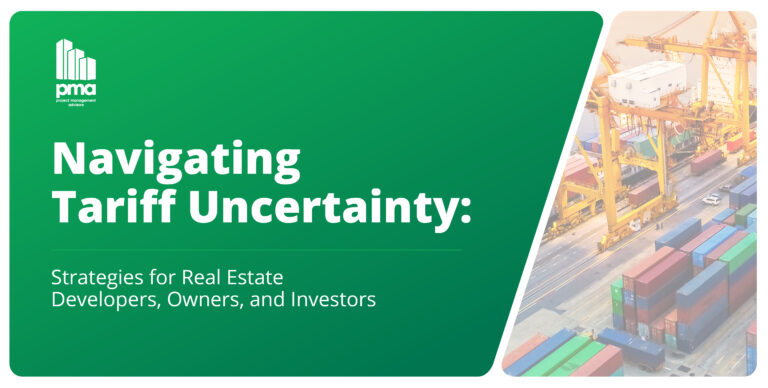The 3 Ps of Multifamily Project Predictability: Process, People, and Product

If You Don’t Know Where You’re Going, How Will You Know When You Get There?
No developer has a crystal ball that tells them precisely how a multifamily project will turn out. But you don’t need a psychic to improve predictability. You need a well-coordinated approach to the 3 Ps. By structuring Process, People, and Product strategies, you’ll reduce uncertainty across the project lifecycle. Plot the path to better project outcomes with a clear roadmap of timelines, budgets, and deliverables, and the insight to anticipate potential roadblocks before they arise.
With predictability, developers and owners can avoid a slew of risks, including:
- Exceeding the budget
- Being handcuffed by local regulations
- Missing key deadlines
- Misjudging the marketing
- Reducing potential ROI
- Canceling the project before ground is broken
- Abandoning a partially finished project
Given its direct impact on feasibility and risk, predictability in multifamily development shouldn’t be a nice-to-have; it should be a guiding principle for every project. By applying best practices every step of the way, from nailing down the entitlement process and navigating myriad regulations, to assigning the proper internal resources, developers can gain the insights it takes to steer a project to success.
“A well-planned approach not only meets financial targets,” said Omar Rihani, PMA’s National Residential Sector Lead. “It helps you create a high-quality, profitable property — one that developers will be proud of, that will lease well, and that will provide ‘moments of Wow!’ in competitive markets.”
Achieving this level of foresight may seem daunting, but it’s entirely possible — when you master the three Ps of predictability. Read on to learn how considering process, people, and product fuels multifamily project success.
1. Process
The first P — process — component of predictability involves eliminating guesswork and reducing risk by identifying procedural obstacles, wrangling financial metrics, and asking the right questions.
Prioritizing process can reduce or eliminate potential snags in multifamily projects, which come with their own unique factors affecting predictability. For example, leasing terms for apartments tend to be much shorter than those for retail, office, and industrial projects. Plus, more thought must be put into tenant amenities for a multifamily project than, say, an industrial project. Furthermore, multifamily projects typically fall under different local regulations than other projects do.
Identifying Procedural Obstacles
Identifying procedural obstacles in a multifamily project early on can save time and money and prevent future headaches. Among the common procedural obstacles that can affect a project’s predictability, timeline, and costs are:
Market-specific factors. Geographic differences affect demand, construction costs, schedule, and approval processes. For example, while the San Francisco market might be experiencing a shortage of multifamily, it’s also among the most expensive markets to build in right now. Meanwhile, the Dallas market might be dealing with a glut of apartments, but construction costs there are generally lower than the national average. It’s a complex algorithm that varies widely by market, so it’s vital to review all the data on material costs, labor availability, and demographics before proceeding in any given location.
What’s more, some markets are better targets for certain property types than others. Consider for instance how high-rise apartments perform well in Boston, while garden-style apartments are more popular in parts of South Florida.
Navigating local government codes. When it comes to codes and local requirements, every location is unique. One local government may restrict the height of multifamily projects, while a neighboring government might limit the number of units that multifamily projects can include. Different jurisdictions may have square-footage requirements for studio units, which can vary widely based on local zoning codes. And some markets may also have energy-efficiency standards for mechanical, electrical, and plumbing (MEP) systems, which can add to up-front costs.
Achieving compliance may look different market to market, but it typically comes at some cost. A 2022 survey by the National Association of Home Builders and the National Multifamily Housing Council found that regulations account for an average of 40.6% of multifamily development costs. The goal is to secure project entitlements while minimizing costly disruptions or delays from overlooked requirements. This means understanding local rules well before a property is cleared for construction.
Wrangling Financial Predictability Over a Project’s Lifecycle
If done right from the beginning, underwriting, and financial modeling can be a significant driver of project predictability. Getting a handle on financial predictability can mean the difference between a project coming in on budget and being hit with cost overruns.
Financial modeling must be tied to a project timeline in order to ensure predictability. This analysis enables a developer to examine cash flow, costs, ROI and profitability, among other factors. In the absence of financial modeling, the viability of a multifamily project becomes uncertain — or worse.
“What’s the role of financial modeling in predictability? It’s everything,” said Peter Jones, PMA Project Director. “Without a solid financial model tied to a project’s timeline, developers risk cost overruns, cash flow issues, and missed milestones. A well-built model ensures every financial decision is backed by data, reducing uncertainty and keeping the project on track.”
A project timeline is an essential accompaniment to that financial modeling. Without adopting a clear timeline — and without sticking to that timeline — the project is likely to end up off track. Deadlines are missed, goals are not likely to be reached, and costs are bound to skyrocket. By shaping an informed, achievable project timeline, and sticking to it, development can run smoothly.
Asking the Right Questions
Here’s where the team need to put their thinking caps on. Posing the right questions before a project proceeds to construction will head off costly, time-sucking issues. Ultimately, it comes down to the 5 Ws: who, what, when, where and why? Who is the target tenant for this property? What issues are we solving? When does the project need to be completed? Where is the best site for my project? And why are we proposing this development?
Rather than treating process as an administrative hurdle, developers who embrace it as a proactive strategy gain a competitive advantage.
2. People
The second P in the predictability equation is people.
“Your people are by far the most important tools in a multifamily project — far more than budgets, timelines, or construction equipment,” said Rihani. “It’s vital to make sure you have the right number of people, with the right skills set — and the right qualities to contribute to a successful team.”
From the very beginning, assembling the right team members can make or break a project. It’s critical to have trusted team members involved in each facet of the project, both internally and externally. For example, the lender and general contractor should be valued members of the project team — a step beyond a typical vendor relationship.
The makeup of the team may also shift depending on the project’s stage. For instance, student housing projects often require double the personnel in the summer months compared to other times of the year, highlighting the importance of adjusting staffing needs based on specific project timelines and demands.
Identifying and Leading External Project Stakeholders
Bringing together the right internal team members is key. So, too, is bringing together the right external team members. Whether it’s a general contractor, architect, or vendor, you should thoroughly check out each one.
Questions you might weigh include:
- Have they worked on multifamily projects? If so, how long have they worked on multifamily projects?
- What is their overall track record and reputation?
- What is their approach to multifamily development?
- Have they been sued by clients?
- How do their costs compare with competitors’ costs?
- Who on your internal team will manage the work of outside stakeholders?
Keep in mind that any one of these external stakeholders could turn the predictability of your project upside down. The success of your project depends on every link in the chain being strong. Above all else, you should be able to trust that the input and work of each outside stakeholder won’t weaken the chain.
Navigating Personnel Disruptions
Predicting how internal and external team members will interact is nearly impossible. However, when issues do arise, you should be prepared to spring into action to prevent harm. Acting quickly can keep small problems from becoming big ones.
After all, personnel disruptions can take a serious toll on a project’s predictability. For example, conflicting personalities can lead to costly delays, affecting the project’s bottom line. On the other hand, fostering trust and treating everyone with fairness can enhance predictability and even improve the outlook for future projects.
So, what can you do to keep the peace among your project team members and ensure a more predictable outcome?
- Maintain open communications. This way, everyone is clear about project goals, progress, successes, and dilemmas. As part of this strategy, hold regular meetings where team members can share thoughts and suggestions.
- Make backup plans in case someone leaves your team. For instance, if the project manager takes another job, who will step in to replace them?
- Resolve conflicts quickly. It’s common for two team members to disagree. But if that evolves into a project-complicating hurdle, you might need more than a heart-to-heart talk to move forward. Knowing who has the authority to break logjams and how to move team members to maintain progress, and build relationships, is key.
- Treat everyone fairly. When you evenly spread fairness among your team members, you stand a much better chance of boosting cooperation and keeping costs in check. Internal and external members who deserve your trust can be tremendous assets when trying to maintain project predictability.
3. Product
The third and final P in predictability is product. A project’s predictability is shaped by early-stage design decisions, including material selection, construction typology, and supply chain considerations. These factors directly impact project schedules, cost control, and overall feasibility — especially when comparing different multifamily product types like conventional multifamily and student housing. Additionally, material availability varies by region, so what’s readily accessible in one area may have long lead times or higher costs elsewhere, further influencing project timelines.
Differences in Predictability Across Multifamily Product Types
All multifamily projects are not created equal. A prime example is conventional multifamily versus student housing. Early design choices, including construction methods and material selection, play a primary role in how smoothly a project will progress.
With a conventional multifamily development, components that go into project predictability include:
- Construction typology. Will the project be a mid-rise or high-rise? Would wood, steel, or modular construction provide the best balance of cost, labor, and efficiency?
- Location. Would the ROI be higher if you build in an urban area or suburban area? Where is the most demand?
- Local regulations. Would local government codes make it more difficult to build the type of multifamily project you’re pursuing?
- Material availability. What building materials will best support cost, labor, and scheduling needs?
While those components might be weighed when you’re developing any project, student housing comes with other distinct considerations. These include:
- How close is the proposed site to the campus? Sites closer to universities are often more desirable but come with higher land costs and more complex permitting hurdles.
- What is the target student demographic for the project? The balance between affordability and quality construction is essential, especially when appealing to both students and their parents.
- What are the comparable rental rates for student housing in the same area?
Obstacles to Predictability on Student Housing Projects
One of the main differences with student housing projects versus conventional multifamily projects is the timeline. A conventional multifamily project is often more flexible than a student housing project. Why? Because you want to ensure a student housing project is ready for tenants before the start of a college or university’s school year, typically in late August or early September.
Other possible obstacles include:
- Appealing to student tenants (and their parents). This means balancing cost, location, and amenities to meet market expectations.
- Finding affordable land. Parcels near college and university campuses, particularly those in urban settings, can be pricey.
- Maintaining a balance between the costs of high-quality construction and the need to charge affordable rents.
- Overcoming neighborhood resistance. Some homeowners might object to yet another student housing project in their neighborhood.
- Understanding on-campus vs. off-campus variables. On-campus projects may face more rigidity and delays due to internal bureaucracy, while off-campus student housing may have more flexibility, but experience more external pressures like zoning rules and market competition.
To improve predictability of any student housing project, it’s crucial to consider potential obstacles early on and address them well before dirt is turned. This general principle holds true for all multifamily projects: thoughtful early-stage planning around construction typology, material selection, and supply chain risks can pave the way for smoother execution, helping developers avoid delays and keep projects on time and within budget.
The Bottom Line
Predictability isn’t a bonus — it’s a necessity for successful multifamily development. Developers and project teams must actively assess risks, anticipate challenges, and implement best practices at every stage to stay on track.
With the U.S. needing 4.3 million new apartments by 2035 to meet demand, the opportunity is massive — but only for those who execute with precision.
Prioritize process, build the right team, and align your product with market needs. By embedding predictability into every decision, developers can minimize delays, control costs, and deliver projects that meet investor expectations.
Connect with this article’s contributors:
Omar Rihani, EVP and National Residential Sector Leader
Peter Jones, Project Director
Brad Moeller, Vice President
Mason Miller, Project Director
A New 256-Unit Community Outside of Dallas Takes Shape
Although there are many systemic obstacles to financing multifamily projects, it’s still very doable in the current macroeconomic environment if a given market’s fundamentals are strong.




